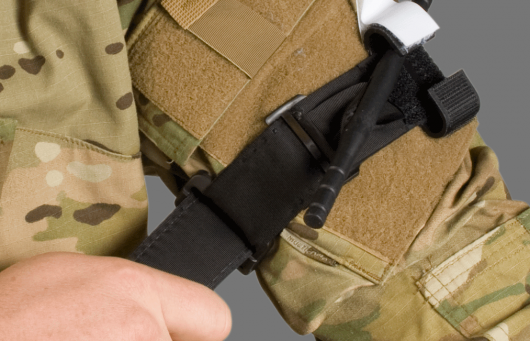Life-Saving Technologies in Armed Conflict

To say that war has evolved is an understatement. The mobilization of large-scale armies in two-sided conflicts is no longer an appropriate definition of modern warfare. For example, consider the various ongoing wars in the Middle East; in many regions, ISIS is fighting against a combination of tribal groups, government forces and civilian militias.
The changing landscape of war, along with changes in war technology, leaves one thing clear: war is no longer country versus country, but rather a scramble for power in volatile regions. However, it is not just the technologies designed to kill that have evolved; life-saving technologies have also made incredible leaps in development.
Evolution of Warfare
As the parameters of war continue to change, so must foreign aid intended to help people caught in armed conflict. Most U.S. foreign aid falls under the “150 account,” a function of the federal budget that contains funding for all international activities. Though function 150 comprises just one percent of the federal budget, it’s responsible for providing all military assistance to allies and aiding in international peacekeeping efforts.
On-going conflicts like those in Syria, Afghanistan and Iran place a heavy strain on U.S. assistance, as the government struggles to provide cost-effective and efficient methods of assistance.
In 2014, president Obama asked Congress to fund a program in which American military personnel would teach Syrian and Jordanian rebels navigation, marksmanship and other skills, in the hopes that they would return to Syria and fight. They recruited about 15,000 men to train in Jordanian territory. One year later, U.S. defense officials admitted that just four or five recruits from the program actually returned to fight.
Meanwhile, the crisis in Syria continues to worsen. Recent estimates place the death toll in Syria at over 200,000 which includes adult civilians and children. About 28,000 deaths can be attributed to shootings and mass killings; often random events that happen with no prior warning.
Paulo Sergio Pinheiro, chairman of the U.N. panel investigating human rights abuses in Syria, explains how “everyday decisions- whether to visit a neighbor, to go out and buy bread- have become, potentially, decisions about life and death.”
Maybe it’s time to rethink how the government can best support civilians and the Syrian National Coalition. Train and equip programs like that of 2014 seem to be a process of trial and error, as it takes time to access their efficacy and long-term sustainability.
Life-saving Technologies
Still, there are small steps the Department of Defense can take to save Syrian lives without sending in weapons or personnel. Two life-saving technologies, the combat tourniquet and quick-clot, could drastically reduce the number of deaths associated with shootings and mass killings as well as organized fighting between the National Coalition and Assad’s forces.
The combat application tourniquet (CAT) is a 21st take on the conventional tourniquet and one of the most important life-saving technologies. Generally speaking, tourniquet use in combat declined after World War II, when widespread misuse led to excessive blood loss and amputation. In most cases, tourniquets were either too tight or too loose, rendering them useless and inefficient.
In the following decades, field medics and soldiers barely used tourniquets in the Vietnam and Korean wars. Unlike its traditional predecessor, the CAT is incredibly easy to use and much more effective. A recent study by the Israeli Defense Forces (IDF) found a 78% success rate when compared to alternative methods for stopping a bleeding.
The CAT’s Out of the Bag
Designed to be used with one hand, the CAT features an adhesive band and friction-adapting buckle to fit anything from an arm to thigh. It also has a free-moving internal band that provides the circumferential pressure necessary for stopping blood flow.
The major difference between the CAT and the traditional tourniquet is that a traditional tourniquet needs to be tied. The CAT’s design makes it possible for a wounded individual to use the device on him or herself, without having to wait for a medic (although it’s still possible for one person to use the CAT on another).
The same study by the IDF claims that the CAT is easy to use and is relatively painless compared to other methods. Its one-handed and foolproof design makes it an ideal technology for war-torn regions where the majority of casualties are related to bullet wounds and blood loss. The U.S. military-issued CAT is priced at about $30.
Clots Begone
Combat Gauze, colloquially termed “QuikClot” is another one of the life-saving technologies at a lower cost (about $8-$40 per packet, depending on the retailer). QuikClot is a hemostatic agent, which means it stops blood loss by helping the blood rapidly clot. Kaolin, the primary clotting agent, works on contact with blood by initiating factor XII, which then transforms into Factor XIIa. XIIa is the molecular cascade responsible for clotting.
The physical gauze conforms to the wound and immediately triggers this process. The 2013 Journal of the American Association of Nurse Anesthetists features a study that found QuikClot effectively stopped hemorrhaging — without complications — 79% of the times it was used by the Israeli Defense forces in Gaza.
The journal also features data to show that QuikClot allowed more effective fluid resuscitation (blood transfusions) and better helped the clot withstand movement compared to other methods.
Packaged in small pouches, QuikClot can be distributed in mass quantities and used without instructions besides those printed on the back of the pouch.
Foreign aid plays a critical role in the United States’ efforts to help people in war-torn regions. As such, it is imperative for aid packages to be cost-effective and fast-acting.
The Combat Application Tourniquet and QuikClot are two life-saving technologies suited to meet the medical needs of many civilians and soldiers affected by armed conflict, especially those in Syria, where thousands of men, women and children continue to die because of blood loss.
– Jessica Levitan
Photo: Officer Survival
